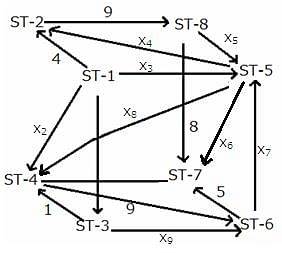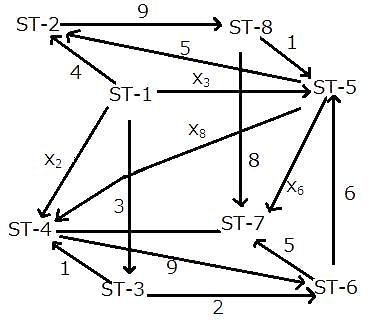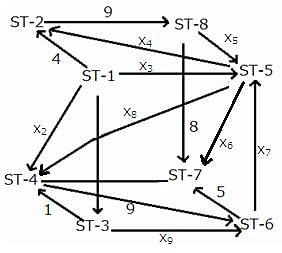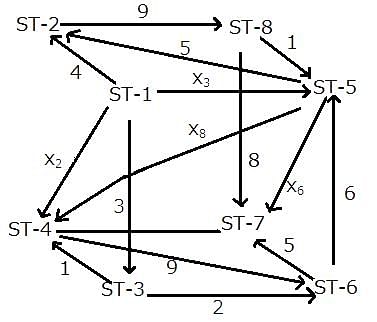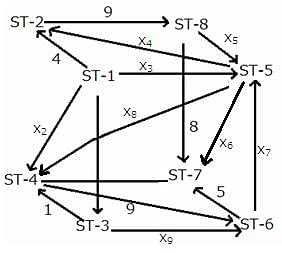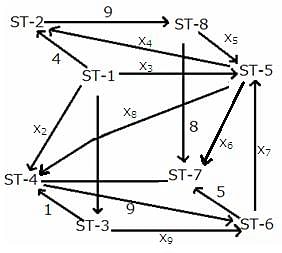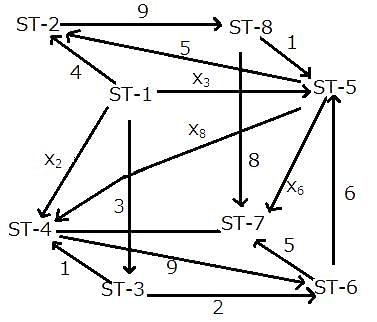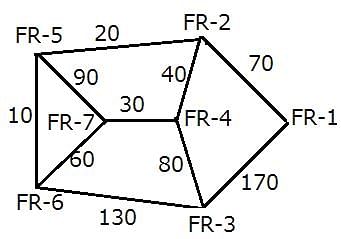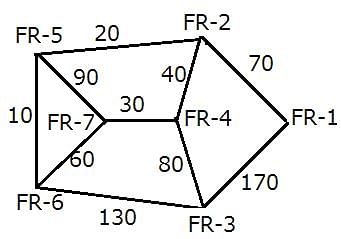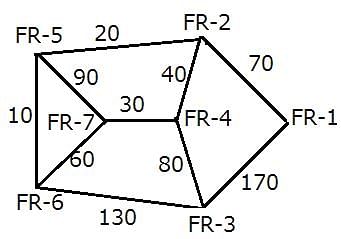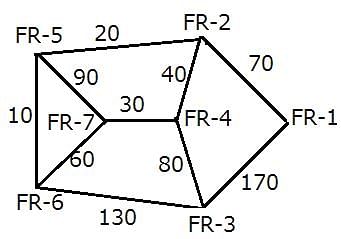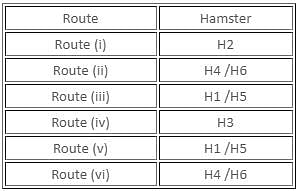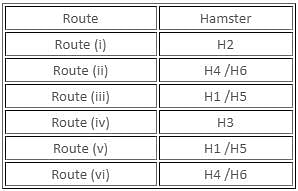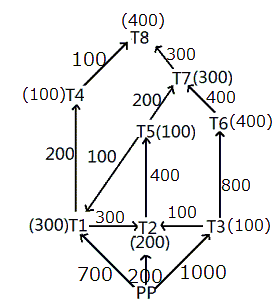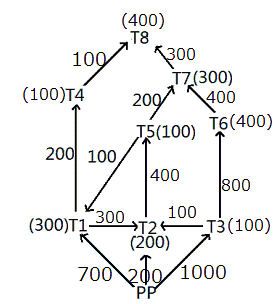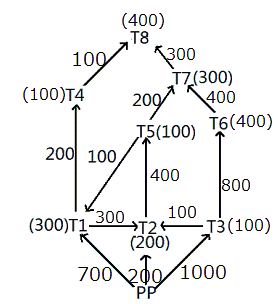Test Level 3: Critical Path - CAT MCQ
15 Questions MCQ Test Level-wise Tests for CAT - Test Level 3: Critical Path
Directions: Read the given information carefully and answer the question that follows.
The given network diagram consists of eight railway stations, where railway station ST–1 represents a railway junction, and the rest represent other stations. The railway lines connecting the various railway stations, represent the tracks on which the trains run and the arrows indicate the direction of trains on tracks. The numbers mentioned alongside some of the arrows indicate the number of trains running on a track on any particular day. It is known that ST–2, ST–3, ST–4, ST–5, ST–6, and ST–8 are just for passage of trains and ST–7 is the only stop at which the journey ends.

The following additional information is known:
No two railway tracks connected to a railway station have the same number of trains running through them in a day.' The number of trains running through each railway track in a day is a positive integer less than 10. The train running on the railway track connecting ST–3 and ST–6 is the least possible number.
What is the total number of trains starting from ST-1?
The given network diagram consists of eight railway stations, where railway station ST–1 represents a railway junction, and the rest represent other stations. The railway lines connecting the various railway stations, represent the tracks on which the trains run and the arrows indicate the direction of trains on tracks. The numbers mentioned alongside some of the arrows indicate the number of trains running on a track on any particular day. It is known that ST–2, ST–3, ST–4, ST–5, ST–6, and ST–8 are just for passage of trains and ST–7 is the only stop at which the journey ends.

The following additional information is known:
No two railway tracks connected to a railway station have the same number of trains running through them in a day.' The number of trains running through each railway track in a day is a positive integer less than 10. The train running on the railway track connecting ST–3 and ST–6 is the least possible number.
Directions: Read the given information carefully and answer the question that follows.
The given network diagram consists of eight railway stations, where railway station ST–1 represents a railway junction, and the rest represent other stations. The railway lines connecting the various railway stations, represent the tracks on which the trains run and the arrows indicate the direction of trains on tracks. The numbers mentioned alongside some of the arrows indicate the number of trains running on a track on any particular day. It is known that ST–2, ST–3, ST–4, ST–5, ST–6, and ST–8 are just for passage of trains and ST–7 is the only stop at which the journey ends.
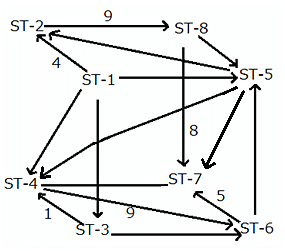
The following additional information is known:
No two railway tracks connected to a railway station have the same number of trains running through them in a day.' The number of trains running through each railway track in a day is a positive integer less than 10. The train running on the railway track connecting ST–3 and ST–6 is the least possible number.
How many trains go from ST-1 to ST-5?
The given network diagram consists of eight railway stations, where railway station ST–1 represents a railway junction, and the rest represent other stations. The railway lines connecting the various railway stations, represent the tracks on which the trains run and the arrows indicate the direction of trains on tracks. The numbers mentioned alongside some of the arrows indicate the number of trains running on a track on any particular day. It is known that ST–2, ST–3, ST–4, ST–5, ST–6, and ST–8 are just for passage of trains and ST–7 is the only stop at which the journey ends.

The following additional information is known:
No two railway tracks connected to a railway station have the same number of trains running through them in a day.' The number of trains running through each railway track in a day is a positive integer less than 10. The train running on the railway track connecting ST–3 and ST–6 is the least possible number.
Directions: Read the given information carefully and answer the question that follows.
The given network diagram consists of eight railway stations, where railway station ST–1 represents a railway junction, and the rest represent other stations. The railway lines connecting the various railway stations, represent the tracks on which the trains run and the arrows indicate the direction of trains on tracks. The numbers mentioned alongside some of the arrows indicate the number of trains running on a track on any particular day. It is known that ST–2, ST–3, ST–4, ST–5, ST–6, and ST–8 are just for passage of trains and ST–7 is the only stop at which the journey ends.
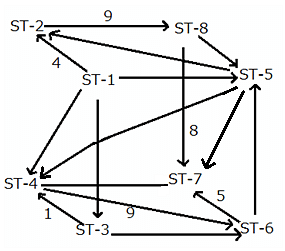
The following additional information is known:
No two railway tracks connected to a railway station have the same number of trains running through them in a day.' The number of trains running through each railway track in a day is a positive integer less than 10. The train running on the railway track connecting ST–3 and ST–6 is the least possible number.
Which of the following statements is/are true?
Statement 1: The number of trains between ST-5 and ST-6 is 8.
Statement 2: The number of trains between ST-5 and ST-4 is more than 2.
The given network diagram consists of eight railway stations, where railway station ST–1 represents a railway junction, and the rest represent other stations. The railway lines connecting the various railway stations, represent the tracks on which the trains run and the arrows indicate the direction of trains on tracks. The numbers mentioned alongside some of the arrows indicate the number of trains running on a track on any particular day. It is known that ST–2, ST–3, ST–4, ST–5, ST–6, and ST–8 are just for passage of trains and ST–7 is the only stop at which the journey ends.

The following additional information is known:
No two railway tracks connected to a railway station have the same number of trains running through them in a day.' The number of trains running through each railway track in a day is a positive integer less than 10. The train running on the railway track connecting ST–3 and ST–6 is the least possible number.
Statement 1: The number of trains between ST-5 and ST-6 is 8.
Statement 2: The number of trains between ST-5 and ST-4 is more than 2.
Directions: Read the given information carefully and answer the question that follows.
The given network diagram consists of eight railway stations, where railway station ST–1 represents a railway junction, and the rest represent other stations. The railway lines connecting the various railway stations, represent the tracks on which the trains run and the arrows indicate the direction of trains on tracks. The numbers mentioned alongside some of the arrows indicate the number of trains running on a track on any particular day. It is known that ST–2, ST–3, ST–4, ST–5, ST–6, and ST–8 are just for passage of trains and ST–7 is the only stop at which the journey ends.
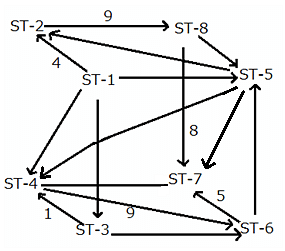
The following additional information is known:
No two railway tracks connected to a railway station have the same number of trains running through them in a day.' The number of trains running through each railway track in a day is a positive integer less than 10. The train running on the railway track connecting ST–3 and ST–6 is the least possible number.
Between which of the following pairs of railway tracks is the number of trains running the same?
Directions: Read the given information carefully and answer the question that follows.
A spy of XYZ kingdom regularly spies between seven enemy camps that are located inside a forest, and are connected to each other by forest roads, FR–1, FR–2, FR–3, FR–4, FR–5, FR–6, and FR–7. The spy has made a map so that he can travel with ease between camps and get the useful information required. However, while travelling between any two enemy camps, the spy always chooses the route which passes through the minimum possible number of enemy camps. If two or more routes pass through the minimum number of enemy camps, he chooses the route for which the distance is also the least. The length of the forest road, directly connecting any two enemy camps, is a multiple of 10. For any pair of enemy camps, the length of a route connecting the two enemy camps and passing through the minimum possible number of enemy camps, is called a forest road stretch between the two enemy camps. The least among all the forest road stretches between two enemy camps is called the minimum forest road stretch between the two enemy camps.
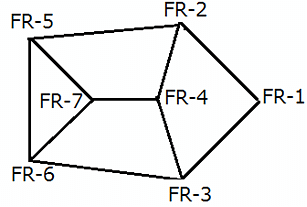
The following information is known about the distances between the enemy camps:
1. The minimum forest road stretch between FR–4 and FR–6 is 90 miles, while the minimum forest road stretch between FR–2 and FR–6 is 30 miles.
2. The highest forest road stretch between FR–1 and FR–7 is 360 miles.
3. The minimum forest road stretch between FR–4 and FR–7 is 30 miles.
4. The sum of the lengths of the road directly connecting FR–5 to FR–6 and that directly connecting FR–5 and FR–7 is 100 miles.
5. The minimum forest road stretch between FR–7 and FR–2 is 70 miles, while the minimum forest road stretch between FR–3 and FR–7 is 110 miles.
6. The length of the road directly connecting FR–3 and FR–6 is greater than 110 miles.
7. The minimum forest road stretch between FR–1 and FR–4 is 110 miles, while the highest forest road stretch between FR–2 and FR–3 is 240 miles.
If the spy has to travel from FR-1 to FR-7, the distance (in miles) that the spy would have to cover is
Directions: Read the given information carefully and answer the question that follows.
A spy of XYZ kingdom regularly spies between seven enemy camps that are located inside a forest, and are connected to each other by forest roads, FR–1, FR–2, FR–3, FR–4, FR–5, FR–6, and FR–7. The spy has made a map so that he can travel with ease between camps and get the useful information required. However, while travelling between any two enemy camps, the spy always chooses the route which passes through the minimum possible number of enemy camps. If two or more routes pass through the minimum number of enemy camps, he chooses the route for which the distance is also the least. The length of the forest road, directly connecting any two enemy camps, is a multiple of 10. For any pair of enemy camps, the length of a route connecting the two enemy camps and passing through the minimum possible number of enemy camps, is called a forest road stretch between the two enemy camps. The least among all the forest road stretches between two enemy camps is called the minimum forest road stretch between the two enemy camps.
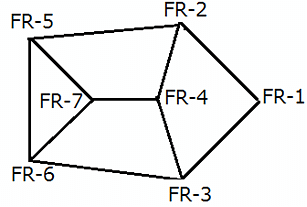
The following information is known about the distances between the enemy camps:
1. The minimum forest road stretch between FR–4 and FR–6 is 90 miles, while the minimum forest road stretch between FR–2 and FR–6 is 30 miles.
2. The highest forest road stretch between FR–1 and FR–7 is 360 miles.
3. The minimum forest road stretch between FR–4 and FR–7 is 30 miles.
4. The sum of the lengths of the road directly connecting FR–5 to FR–6 and that directly connecting FR–5 and FR–7 is 100 miles.
5. The minimum forest road stretch between FR–7 and FR–2 is 70 miles, while the minimum forest road stretch between FR–3 and FR–7 is 110 miles.
6. The length of the road directly connecting FR–3 and FR–6 is greater than 110 miles.
7. The minimum forest road stretch between FR–1 and FR–4 is 110 miles, while the highest forest road stretch between FR–2 and FR–3 is 240 miles.
Between which of the following pairs of enemy camps is the minimum forest road stretch the least?
Directions: Read the given information carefully and answer the question that follows.
A spy of XYZ kingdom regularly spies between seven enemy camps that are located inside a forest, and are connected to each other by forest roads, FR–1, FR–2, FR–3, FR–4, FR–5, FR–6, and FR–7. The spy has made a map so that he can travel with ease between camps and get the useful information required. However, while travelling between any two enemy camps, the spy always chooses the route which passes through the minimum possible number of enemy camps. If two or more routes pass through the minimum number of enemy camps, he chooses the route for which the distance is also the least. The length of the forest road, directly connecting any two enemy camps, is a multiple of 10. For any pair of enemy camps, the length of a route connecting the two enemy camps and passing through the minimum possible number of enemy camps, is called a forest road stretch between the two enemy camps. The least among all the forest road stretches between two enemy camps is called the minimum forest road stretch between the two enemy camps.
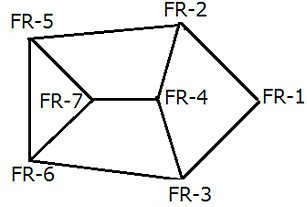
The following information is known about the distances between the enemy camps:
1. The minimum forest road stretch between FR–4 and FR–6 is 90 miles, while the minimum forest road stretch between FR–2 and FR–6 is 30 miles.
2. The highest forest road stretch between FR–1 and FR–7 is 360 miles.
3. The minimum forest road stretch between FR–4 and FR–7 is 30 miles.
4. The sum of the lengths of the road directly connecting FR–5 to FR–6 and that directly connecting FR–5 and FR–7 is 100 miles.
5. The minimum forest road stretch between FR–7 and FR–2 is 70 miles, while the minimum forest road stretch between FR–3 and FR–7 is 110 miles.
6. The length of the road directly connecting FR–3 and FR–6 is greater than 110 miles.
7. The minimum forest road stretch between FR–1 and FR–4 is 110 miles, while the highest forest road stretch between FR–2 and FR–3 is 240 miles.
What is the highest forest road stretch between FR-3 and FR-7?
Directions: Read the given information carefully and answer the question that follows.
A spy of XYZ kingdom regularly spies between seven enemy camps that are located inside a forest, and are connected to each other by forest roads, FR–1, FR–2, FR–3, FR–4, FR–5, FR–6, and FR–7. The spy has made a map so that he can travel with ease between camps and get the useful information required. However, while travelling between any two enemy camps, the spy always chooses the route which passes through the minimum possible number of enemy camps. If two or more routes pass through the minimum number of enemy camps, he chooses the route for which the distance is also the least. The length of the forest road, directly connecting any two enemy camps, is a multiple of 10. For any pair of enemy camps, the length of a route connecting the two enemy camps and passing through the minimum possible number of enemy camps, is called a forest road stretch between the two enemy camps. The least among all the forest road stretches between two enemy camps is called the minimum forest road stretch between the two enemy camps.
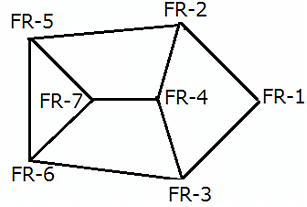
The following information is known about the distances between the enemy camps:
1. The minimum forest road stretch between FR–4 and FR–6 is 90 miles, while the minimum forest road stretch between FR–2 and FR–6 is 30 miles.
2. The highest forest road stretch between FR–1 and FR–7 is 360 miles.
3. The minimum forest road stretch between FR–4 and FR–7 is 30 miles.
4. The sum of the lengths of the road directly connecting FR–5 to FR–6 and that directly connecting FR–5 and FR–7 is 100 miles.
5. The minimum forest road stretch between FR–7 and FR–2 is 70 miles, while the minimum forest road stretch between FR–3 and FR–7 is 110 miles.
6. The length of the road directly connecting FR–3 and FR–6 is greater than 110 miles.
7. The minimum forest road stretch between FR–1 and FR–4 is 110 miles, while the highest forest road stretch between FR–2 and FR–3 is 240 miles.
The spy's companion, Mr. Y, always travels along the shortest route when travelling from one enemy camp to another. On a particular day, both, the spy and Mr. Y, started from FR-1 and reached X, which is one of the other six enemy camps. If the length of the route that the spy took is greater than that of the route that Mr. Y took, how many of the six enemy camps were there in the route of the spy?
Directions: Read the given information carefully and answer the question that follows.
In a hamster running game, starting point X and end point Y are connected by a grid of 12 hamster running tracks, all of same length, numbered ''a'' to ''l'', as shown below. The meeting point of two or more tracks is called a track meeting point (TMP), represented by ''z'', where 'z' is the number of tracks meeting at that point. However, X and Y are not TMPs as they are the start and end points.
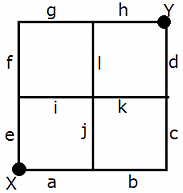
Six hamsters, H1, H2, H3, H4, H5, and H6, started at the same time from X, and ran to Y at the same speed. No two hamsters ran together for the entire track, and each hamster ran along a route of the minimum possible length. It is also known that H2 and H3 did not travel through the four-track TMP, while H4 ran alongside H6 on track-k, and H3 ran alongside H5 on track-h.
If H6 and H1 did not come across each other, except at the four-track TMP, then the number of tracks along which H4 ran alongside H2 is at most
Directions: Read the given information carefully and answer the question that follows.
In a hamster running game, starting point X and end point Y are connected by a grid of 12 hamster running tracks, all of same length, numbered ''a'' to ''l'', as shown below. The meeting point of two or more tracks is called a track meeting point (TMP), represented by ''z'', where 'z' is the number of tracks meeting at that point. However, X and Y are not TMPs as they are the start and end points.
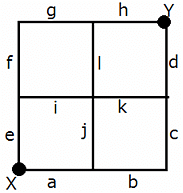
Six hamsters, H1, H2, H3, H4, H5, and H6, started at the same time from X, and ran to Y at the same speed. No two hamsters ran together for the entire track, and each hamster ran along a route of the minimum possible length. It is also known that H2 and H3 did not travel through the four-track TMP, while H4 ran alongside H6 on track-k, and H3 ran alongside H5 on track-h.
If track-i and track-k were closed due to damage and some of the hamsters changed their routes in a manner such that no three hamsters ran together for the entire journey (instead of no two hamsters, as mentioned above), then what would be the difference between the number of hamsters who used track-h and the number of hamsters who used track-d?
Directions: Read the given information carefully and answer the question that follows.
In a hamster running game, starting point X and end point Y are connected by a grid of 12 hamster running tracks, all of same length, numbered ''a'' to ''l'', as shown below. The meeting point of two or more tracks is called a track meeting point (TMP), represented by ''z'', where 'z' is the number of tracks meeting at that point. However, X and Y are not TMPs as they are the start and end points.
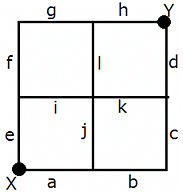
Six hamsters, H1, H2, H3, H4, H5, and H6, started at the same time from X, and ran to Y at the same speed. No two hamsters ran together for the entire track, and each hamster ran along a route of the minimum possible length. It is also known that H2 and H3 did not travel through the four-track TMP, while H4 ran alongside H6 on track-k, and H3 ran alongside H5 on track-h.
Which of the following statements is definitely true?
Directions: Read the given information carefully and answer the question that follows.
Given below is a network of high tension wires from power plant (PP) and 8 transformers T1 to T8. The requirement of power by transformer is exactly met by the electric power provided by the power plant. The electric power in some of the high tension wires and the requirement at some of the transformers has also been mentioned. PP is the source transformer, i.e. the PP does not have any requirement of its own, but it supplies the requirements of all the other transformers.(All values shown in the figure are in KW.)
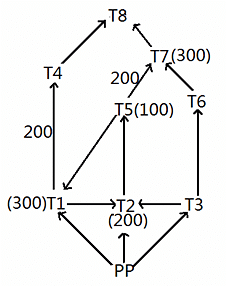
It is also known that:
i. The maximum capacity of any high tension wire is 1000 KW.
ii. The requirement at any transformer, except the power plant and T8, is equal to the flow in exactly one of the high tension wires directly connected to it.
iii. No two high tension wires, directly connected to the same transformer, carry the same amount of electric power.
iv. The flow in none of the high tension wires shown above is zero.
What is the requirement of power (in KW) at the transformer T8?
Directions: Read the given information carefully and answer the question that follows.
Given below is a network of high tension wires from power plant (PP) and 8 transformers T1 to T8. The requirement of power by transformer is exactly met by the electric power provided by the power plant. The electric power in some of the high tension wires and the requirement at some of the transformers has also been mentioned. PP is the source transformer, i.e. the PP does not have any requirement of its own, but it supplies the requirements of all the other transformers.(All values shown in the figure are in KW.)
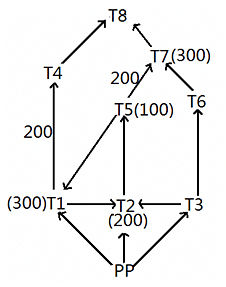
It is also known that:
i. The maximum capacity of any high tension wire is 1000 KW.
ii. The requirement at any transformer, except the power plant and T8, is equal to the flow in exactly one of the high tension wires directly connected to it.
iii. No two high tension wires, directly connected to the same transformer, carry the same amount of electric power.
iv. The flow in none of the high tension wires shown above is zero.
What is the amount of electric power (in kW) carried by the high tension wire T3-T6?
Directions: Read the given information carefully and answer the question that follows.
Given below is a network of high tension wires from power plant (PP) and 8 transformers T1 to T8. The requirement of power by transformer is exactly met by the electric power provided by the power plant. The electric power in some of the high tension wires and the requirement at some of the transformers has also been mentioned. PP is the source transformer, i.e. the PP does not have any requirement of its own, but it supplies the requirements of all the other transformers.(All values shown in the figure are in KW.)
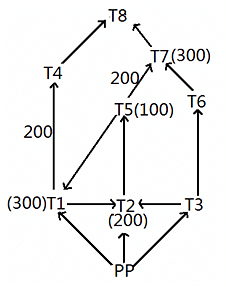
It is also known that:
i. The maximum capacity of any high tension wire is 1000 KW.
ii. The requirement at any transformer, except the power plant and T8, is equal to the flow in exactly one of the high tension wires directly connected to it.
iii. No two high tension wires, directly connected to the same transformer, carry the same amount of electric power.
iv. The flow in none of the high tension wires shown above is zero.
What is the total requirement of power(in kW) that should be supplied by the power plant?
Directions: Read the given information carefully and answer the question that follows.
Given below is a network of high tension wires from power plant (PP) and 8 transformers T1 to T8. The requirement of power by transformer is exactly met by the electric power provided by the power plant. The electric power in some of the high tension wires and the requirement at some of the transformers has also been mentioned. PP is the source transformer, i.e. the PP does not have any requirement of its own, but it supplies the requirements of all the other transformers.(All values shown in the figure are in KW.)
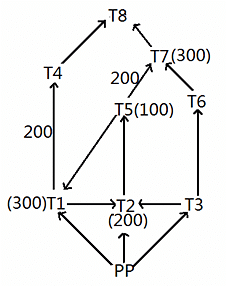
It is also known that:
i. The maximum capacity of any high tension wire is 1000 KW.
ii. The requirement at any transformer, except the power plant and T8, is equal to the flow in exactly one of the high tension wires directly connected to it.
iii. No two high tension wires, directly connected to the same transformer, carry the same amount of electric power.
iv. The flow in none of the high tension wires shown above is zero.
What is the amount of electric power (in kW) carried by the high tension wire T2-T5?
|
5 docs|272 tests
|


